Donor Healing Study With Verteporfin By Dr. Barghouthi
This page will chronicle the verteporfin experimental pilot study being undertaken by Dr. Taleb Barghouthi of the Vertex Hair Clinic. The purpose of the study is to observe the effects of verteporfin injected into FUE surgical extraction wounds. Decreased scarring and/or donor hair follicle regeneration are potential outcomes of this treatment. Documented test areas on the scalp received verteporfin injections, while control areas received a phosphate-buffered saline (salt) injections.
Timeline Of First Verteporfin Patient
500 Days
The latest photos are just under 1.5 years from the date of the original surgery. Dr. Barghouthi shared the below photos on the HTN forum and added a few words as well: "As mentioned in a previous post, I continue to see the consistent difference between injected and control sites. I think the 0.4 area has been showing the best overall progress- but I also think that we do notice changes in the other doses too. The zoomed out 0.4 area looks to me untouched- but that’s only my subjective judgement. I was also happy to see the 0.24 mg area catching up to show better visual recovery and that might be due to the fact that this area had tumescent fluids injected in it, leading to vasoconstriction."
It can be said that the outlined area of the test section, which received verteporfin injections, appears to be much more filled in with hair compared to the control area. I also agree that the 0.4mg test section appears almost untouched, while the 0.4mg control section shows obvious signs of donor harvesting. It's a truly great potential at this time, but a question which I find extremely important, and hasn't been addressed yet, is how are these sections being accurately identified a year past the surgery? I.e. Can we be sure that the 0.4mg test and control sections (which assumedly were outlined again for this recent patient checkup) are the same exact areas outlined prior to the surgery? If they are, then the future looks very bright for verteporfin in hair transplant surgery.
The 0.24mg test and control sections appear similar in comparison below.
119 Days
This next round of photos from 119 days (about 4 months) post-op continue to display compelling and surprising data from the ongoing verteporfin donor regeneration study. We have three new examples of extraction sites from the 0.4mg, 0.32mg, and 0.24mg test and control zones, as well as two interesting photo comparisons of a slightly wider perspective of the 0.4mg and 0.32mg test and control areas. These latter photos may be the most intriguing photos we've seen so far in this study. Dr. Barghouthi added this commentary to the update: "I continue to see distinct hairs around or within punched areas in the test areas across all doses. I continue to see clearly scarred areas in the control group...I think I will now need to test new doses within 0.4 and above or increase the concentration...I will also proceed with injections in the recipient area and a linear scar injection."
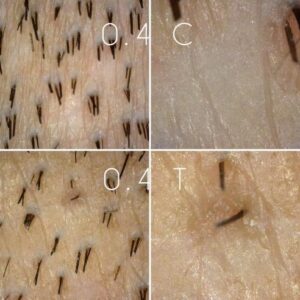 Like most of the comparative examples we see in this study, here is another example of the 0.4mg test area at 119 days showing a new hair sprouting from an apparent extraction site, while the control zone shows nothing but plain scarring.
Like most of the comparative examples we see in this study, here is another example of the 0.4mg test area at 119 days showing a new hair sprouting from an apparent extraction site, while the control zone shows nothing but plain scarring.
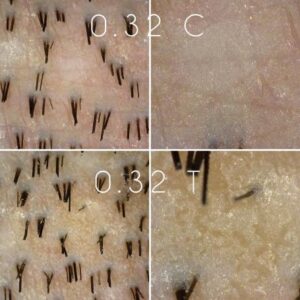 0.32mg areas at 119 days and a continual pattern of some improvement in the test area.
0.32mg areas at 119 days and a continual pattern of some improvement in the test area.
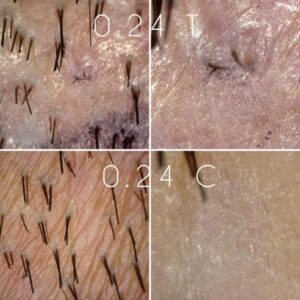 0.24mg at 119 days showing small hairs sprouting in the test area.
0.24mg at 119 days showing small hairs sprouting in the test area.
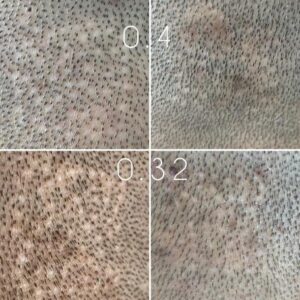 Very compelling visuals in these photos. Objectively, we can clearly see a greater prevalence of scarring in the two left photos (both control). Consequently, there seems to be more hair follicles present in the right photos (verteporfin test). One other observation is the prevalence of hyperpigmentation in the test photos; this is something that should continue to be observed,
Very compelling visuals in these photos. Objectively, we can clearly see a greater prevalence of scarring in the two left photos (both control). Consequently, there seems to be more hair follicles present in the right photos (verteporfin test). One other observation is the prevalence of hyperpigmentation in the test photos; this is something that should continue to be observed,
84 Days
These comparative photos shared by Dr. Barghouthi show images from the test areas on top and control areas beneath, in different magnifications. For clarity, I must also mention that these extraction sites are not necessarily the same sites shown in previous updates as it is too difficult to track specific sites without using a tattoo mark. These photos compare what typical extraction sites look like in the treated areas compared to the control areas of the same concentration. As you can see, the tested/treated areas "T" receiving verteporfin continue to show new hair emerging from extraction sites while the control areas "C" show tissue which is very barren and dull looking. Can we say it is a breakthrough yet? I think we can say these data absolutely warrant a full-scale clinical investigation of verteporfin in donor extraction sites.
0.24mg sites at 84 days. The two small terminal hairs emerging around the other hairs which are markedly longer is remarkably intriguing.
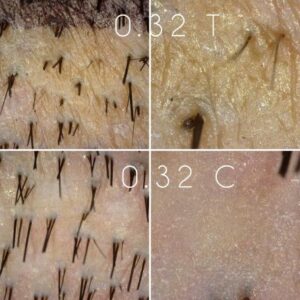 0.32mg sites at 84 days. The test photos appear to show multiple sites with hairs emerging which are uncharacteristic from the native donor hairs.
0.32mg sites at 84 days. The test photos appear to show multiple sites with hairs emerging which are uncharacteristic from the native donor hairs.
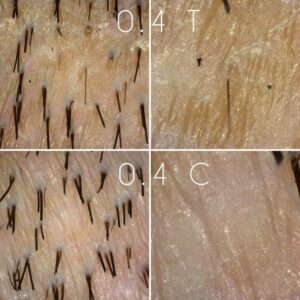 0.4mg sites at 84 days. A solitary hair appears to be emerging directly from the center of an extraction site.
0.4mg sites at 84 days. A solitary hair appears to be emerging directly from the center of an extraction site.
~55 Days
A terminal hair is visibly protruding in the vicinity of the 0.4 test extraction site. Is this coming out of the extraction site or was this there all along? Note the size difference in diameter of the hair shafts around this new singular sprouting hair.
One of the most interesting result thus far, a fine hair can be seen protruding in the 0.32 test area which received verteporfin.
A thin hair appears to be protruding directly from the discolored extraction area. This is close to definitive proof that a hair has regenerated from a healing FUE extraction site. Note, this 0.32mg site is different from the one above as the new hairs are sprouting in slightly different directions.
30 Days
14 Days & Prior
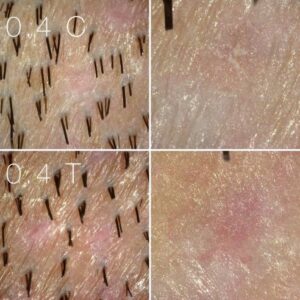
14 days. Trichoscopic and further zoomed images of FUE extraction sites in the 0.4mg test and control sections.
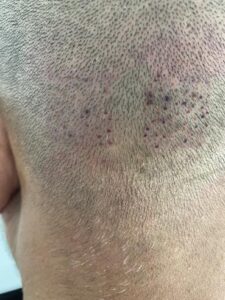
The 0.4mg section (left square) and the control section (right square) two days following treatment. Note the higher prevalence of scabbing in the control section.
As partially displayed in one of the photos above, there are six 2x2cm sections being evaluated in the first patient's donor scalp. Three test sections will receive either 0.4mg, 0.32mg, or 0.24mg injections of verteporfin into their respective FUE extraction sites, and are marked with a "T." There are also three corresponding control sections marked with a "C", these sections will only receive injections of phosphate-buffered saline which is a salt solution. The test layout was recently clarified by Dr. Barghouthi to me.


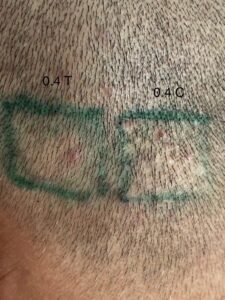
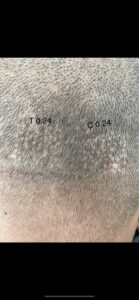
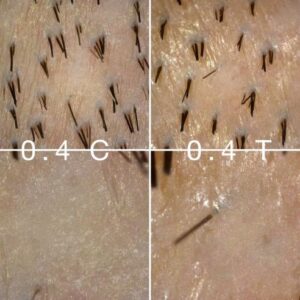
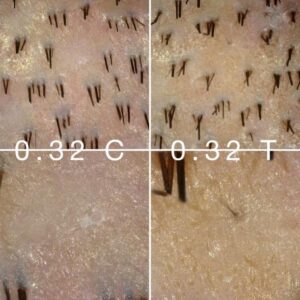
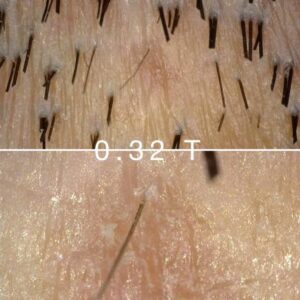
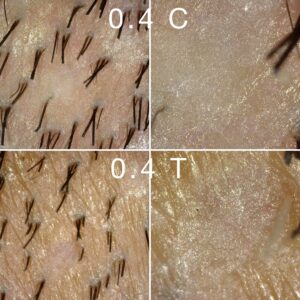

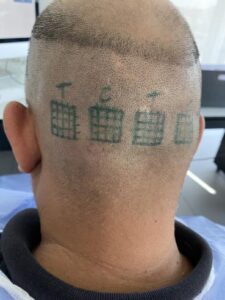
So far at 30 days I think the results cannot be conclusive yet, but the 0.4mg test extraction site seems to have slightly more of a normal skin appearance compared to control.
Interesting – seems that at 14 days the test site had more hyperpigmentation … makes you think that the delay in healing prevents the scar from forming a bit? What is your thinking on this one, not asking for a crystal ball but what your gut says. Is this working as we hoped, is it the answer as is, do we need to try different doses, or more likely a bust?
At this very early stage I think we may need to try different doses, but I especially think that trying with an FUT wound will be determining factor to see how big the difference in healing/scarring is.
Wow is that hair at 0.4 one of the potentially “new” terminal hairs
It definitely is potentially a regenerated new hair Skye, it’s just not as concrete as the 0.32 hair. It’s easy to see that the 0.32 hair is growing right out of an extraction site. However, when I look at the thick hairs around the potentially new 0.4 hair, they all seem to be going in a different direction than the new hair, and they are all a bit thicker and double/triple follicles. That new one stands out. It’s a good sign to be honest. 🤞
Yeah it needs to be done via FUT.
Was verteporfin only used once, the day of the procedure? I’m pretty sure in the study with pigs wound dressings were applied for the first 90 days. Hopefully a similar method is being used since we know that’s how the scarless results and hair regeneration were achieved.
Yes, verteporfin was used only once.
Do we have any news about hair growth??
There should be another photo update tomorrow Mario.
Latest update – oh my god!
– Can we be sure these are not just resected hairs?
– Could this effect potentially be augmented with silica gel?
Paro, at this early stage it is still a possibility these are transected hairs. I don’t know about the effects of silica gel.
Thanks @Follicle Thought. I guess the jury’s still out.
some new?
Absolutely incredible. I wonder if multiple injections would have improved the results, certainly something to consider in future studies.
How long is this study supposed to go on for?
Wow looks promising.
I do know that the Dr mentioned he would be doing a full transplant early September. Wonder if he’d be able to give an update on this?
https://www.hairrestorationnetwork.com/topic/64737-verteporfin-hair-regeneration-human-trial-dr-barghouthi-official-thread/page/3/
Beauty! Thanks for keeping us updated Follicle Thought!
Does the doctor have other patients he is testing on? have you sent this to other docs to share that may not be aware of this work?
I did post a comment but I think it having a link removed it.
The Dr did say he had a full FUE patient lined up for early September.
Skye, you are right. Your post was sent to spam by the automatic wordpress system. I went and retrieved your comment after you mentioned it. Sometimes comments with links get through and sometimes they do not, I don’t know exactly why.
johnny, I shared the information on my website which is read around the world. That’s the best I will do at the moment. Also, I believe Dr. B will try other patients soon.
I wonder how long it will be before more doctors start trialling this off label with their patients. WIth each update, the results are looking more and more interesting and like verteporfin will actually minimise scarring and regrow some hairs. After all, there’s a business incentive for doctors should this be proven to work reliably; more donor hairs, more potential surgeries.
One thing to note is that the hairs in the verteporfin treated areas seem to be thinner and less pigmented than the rest of the native donor area. I wonder if this is because the hair is ‘new’ and needs time in the anagen phase to grow and become a full and normal terminal hair like the remainder of the donor area. I guess only time will tell
Since different sites were used each time, did any of the controls show telogen hairs coming out after the extraction? If hairs were only observed in the treatment areas, then that would confirm that they are in fact new hairs.
Paro, here is a quote from Dr. Barghouthi which pertains to your question “I did notice more scattered budding hairs throughout the three test areas. I couldn’t trace back the previous exact area of last follow up, but a look at most regions showed these tiny and shorter hairs around or within the areas of scarring. This was definitely not seen in control images.“
Absolutely incredible. I’m wondering if Verteporfin can help people who have had transplants would love to see about turning the doner scars back into doner hairs.
By re-punching of old extractions to improve doner area. Or maybe extraction of miniaturized follicles on the top of the scalp to see how they grow back.
This is 100% without a doubt the biggest (however small it is) of a step forward that I’ve personally witnessed in the hair loss community.
I wonder if it makes sense to also inject the recipient area when implanting FUE grafts … you’re creating a wound… can limit scarring… maybe foster better and faster growth … maybe even potentially regenerate dying hairs on top …. Man, I don’t know… makes me feel like I want to get 3 injections at triple strength of this stuff when I get my procedure done …
Although obviously just speculation – a lot of these seem to be growing from the edge of the extraction area, as opposed to in the middle (there are obvious exceptions though). I wonder if there’s anything to that. And if there is, I wonder if that leads the the idea that verteporfin and micro-needling (however deep) could be a thing. Exciting regardless!
I wonder if you puncture the bald areas – will it grow hair?
There is a lot to learn and a lot of studies to make, but it already looks very promosing.
Wonder how many % of punctured points will grow hairs
That’s what I am thinking. Minor scars, like derma rolling, then injections. Could this work? Would be wonderful.
Seems other Doctors have been trying verteporfin on scars and have been having success with removing old scars with skin.
https://www.realself.com/review/scar-removal-scarless-healing-verteporfin-scar-revision
Wow. 4 months in and still looks promising. Something to note is, I believe the pig studies took 6 months for the full effects, maybe longer, might end up having some more improvement still.
Hopefully now we can get other Doctors start testing with Verteporfin. I know other Doctors have been trying it to reduce existing scars which seemed to work. Here’s hoping.
Thanks for the coverage of these updates Follicle Thought. Over at the Hair Restoration Network in the trial thread, there’s an appetite amongst the forum members for getting more doctors on board with verteporfin research and testing to both speed up the protocol development time and to take the onus off of Dr. Barghouthi who is, so far, the only one publicly trialling this for HT surgery. Just wondered if you had any links with any HT surgeons and clinics to see if they’d be interested in getting on board with this research.
Think this treatment has potential to both improve patient outcomes and to lead to more surgeries for HT surgeons, so it should hopefully be a win win for all involved when/if it’s rolled out more mainstream.
Thanks!
this would be amazing for use in body hair. imagine if you could have all your chest hair removed, nape hair removed, and have no scarring. That would be a great filler for a lot of us!
Looks like no difference between 84 days and 114 days, in my opinion. So in extraction did he fully remove the hair follicle? If so then it might be like in hair transplants where there’s growth at first, then the “ugly duckling” phase where all the transplanted hairs fall out a few months in, before regrowth actually starts again.
In FUE, they remove intact follicular units. To see any hair regrowing from the extraction sites is a big deal, because it means the verteporfin causes the skin to regrow as skin (with new follicular units) instead of barren scar.
Your “ugly duckling” thought could be true, but we don’t know for sure. Maybe it grows and ejects hair, then regrows for good. Also, we don’t know if he used the ideal dosage for regrowing hair follicles, he’s figuring that out with trial and error.
The other thing to keep in mind is that he’s not showing the exact same patch of scalp in each monthly update. To find the exact spot, he’d have to have tattooed the patient’s scalp to make sure they’re looking at the same spot — that’s the most scientific way to do it. But we can still see progress and a difference between the control and test areas, it looks really promising.